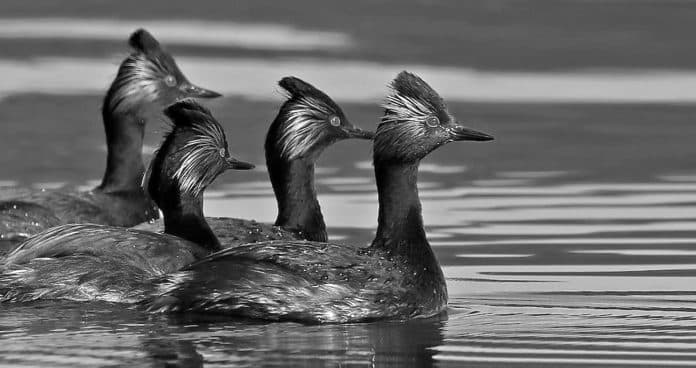A Closer Look at the Eared Grebe in Tanzania: Unraveling the Secrets of this Aquatic Marvel
The Eared Grebe is a freshwater bird that is quite common in Tanzania. This bird is known for its distinctive appearance, which includes a black cap and a red eye. The Eared Grebe is also known for its unique feeding habits and breeding patterns. In this article, we will take a closer look at the Eared Grebe in Tanzania and unravel the secrets of this aquatic marvel.
Introduction to the Eared Grebe in Tanzania
The Eared Grebe is a small bird that belongs to the family Podicipedidae. This bird is found in various parts of the world, including Tanzania. The Eared Grebe is characterized by its small size, black cap, and red eye. It is also known for its distinctive call, which is a high-pitched trill.
The Eared Grebe is a migratory bird, which means that it travels long distances from its breeding grounds to its wintering grounds. In Tanzania, the Eared Grebe is found in various freshwater habitats, including lakes, ponds, and reservoirs.
Physical characteristics of the Eared Grebe
The Eared Grebe is a small bird that measures about 23 to 27 centimeters in length and weighs about 200 to 300 grams. It has a black cap on its head and a red eye. The body of the Eared Grebe is brownish-black in color, and its wings are short and pointed.
The Eared Grebe is also known for its unique feet, which are lobed and have no webbing. These lobes help the bird to swim and dive in the water. The Eared Grebe is an excellent swimmer and can dive to a depth of up to 20 meters.
Habitat and distribution of the Eared Grebe in Tanzania
The Eared Grebe is found in various freshwater habitats in Tanzania, including lakes, ponds, and reservoirs. It is also found in other parts of the world, including North America, Europe, and Asia.
During the breeding season, the Eared Grebe is found in large colonies on shallow lakes and ponds. After the breeding season, the Eared Grebe migrates to its wintering grounds, which are located in the southern hemisphere.
Behavior and feeding habits of the Eared Grebe
The Eared Grebe is a social bird that is often found in large flocks. It is also known for its unique feeding habits, which include diving underwater to catch small fish and invertebrates. The Eared Grebe is an excellent swimmer and can dive to a depth of up to 20 meters.
During the breeding season, the Eared Grebe performs a unique courtship display, which includes a series of head-bobbing and wing-flapping movements. The male Eared Grebe also presents the female with a gift of aquatic vegetation.
Breeding and nesting patterns of the Eared Grebe
The Eared Grebe breeds in large colonies on shallow lakes and ponds. During the breeding season, the male Eared Grebe performs a unique courtship display to attract a mate. After mating, the female Eared Grebe lays a clutch of two to four eggs.
Both the male and female Eared Grebe take turns incubating the eggs and caring for the young. The young Eared Grebes are born with downy feathers and are able to swim and dive within hours of hatching.
Conservation status and threats to the Eared Grebe population in Tanzania
The Eared Grebe is listed as a species of Least Concern by the International Union for Conservation of Nature (IUCN). However, the Eared Grebe population in Tanzania is threatened by habitat loss and degradation, pollution, and human disturbance.
Efforts are underway to protect the Eared Grebe in Tanzania, including habitat restoration and conservation initiatives. Wildlife tourism and birdwatching are also important for raising awareness about the Eared Grebe and its conservation needs.
Research and study efforts on the Eared Grebe in Tanzania
Research and study efforts on the Eared Grebe in Tanzania are ongoing, with a focus on understanding the bird’s ecology and behavior. These efforts include bird banding, population monitoring, and habitat assessments.
Researchers are also studying the effects of climate change on the Eared Grebe population in Tanzania, as well as the impact of human activities on the bird’s habitat.
Wildlife tourism and birdwatching opportunities to observe the Eared Grebe in Tanzania

Tanzania offers excellent opportunities for wildlife tourism and birdwatching, including the chance to observe the Eared Grebe in its natural habitat. The best time to see the Eared Grebe in Tanzania is during the breeding season, which runs from October to April.
Birdwatchers can observe the Eared Grebe on various freshwater habitats in Tanzania, including Lake Victoria, Lake Tanganyika, and Lake Manyara. There are also several birdwatching tours and wildlife safaris that focus on the Eared Grebe and other bird species in Tanzania.
Interesting facts and trivia about the Eared Grebe
- The Eared Grebe is also known as the Black-necked Grebe.
- The Eared Grebe is a skilled diver and can swim and dive underwater for up to 30 seconds.
- The Eared Grebe is an excellent swimmer and can reach speeds of up to 40 kilometers per hour.
Conclusion and importance of protecting the Eared Grebe in Tanzania
The Eared Grebe is a unique and fascinating bird that is an important part of Tanzania’s freshwater ecosystems. Protecting the Eared Grebe and its habitat is essential for maintaining the biodiversity and ecological health of Tanzania’s freshwater systems.
Efforts are underway to protect the Eared Grebe in Tanzania, but more needs to be done. By raising awareness about the Eared Grebe and its conservation needs, we can ensure that this aquatic marvel continues to thrive in Tanzania’s freshwater habitats.
For more articles related to Wildlife in Tanzania (Animals), click here!

































